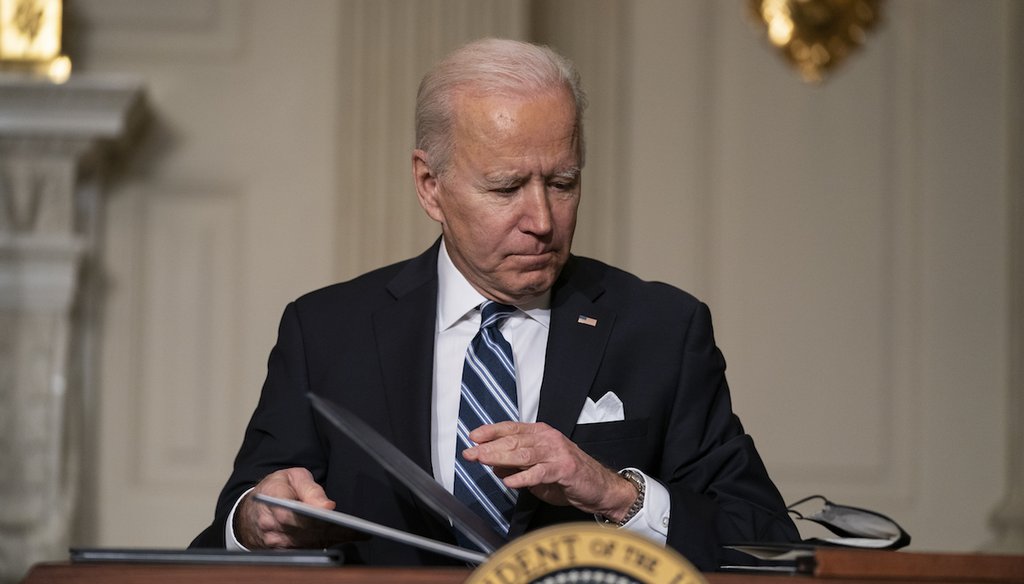Stand up for the facts!
Our only agenda is to publish the truth so you can be an informed participant in democracy.
We need your help.
I would like to contribute
Joe Biden’s moves start the US toward net-zero carbon, but Congress is key

President Joe Biden signs a series of executive orders on climate change. (AP Photo/Evan Vucci)
President Joe Biden's most sweeping climate change promise would produce an America where the release and capture of greenhouse gases are in balance. Whatever carbon got into the air would be offset by natural and man-made carbon capture.
"I will make massive, urgent investments at home that put the United States on track to have a clean energy economy with net-zero emissions by 2050," Biden wrote in March 2020.
At the White House, Biden signed executive orders to move the country in that direction and "supercharge our administration's ambitious plan to confront the existential threat of climate change."
"We can't wait any longer," Biden said Jan. 27.
Biden put a moratorium on new oil and gas leases on federal land. He also ordered federal agencies to buy zero-emission vehicles that are made in the U.S., and, where possible, to eliminate fossil fuel subsidies. He created a new White House office to keep climate change part of every department's activities, and he tied all of these efforts to creating millions of jobs.
Coming on top of his moves on his first day in office, Biden has laid the groundwork to move the country toward net-zero emissions. But experts caution that Biden will need Congress to reach that goal.
Biden's executive actions put a number of regulatory steps in motion.
He started the paperwork to bring the U.S. back into the Paris Climate Agreement.
Departments and agencies began drafting rules to cut methane gas escaping from oil and natural gas operations. The administration re-started discussions to set new fuel efficiency standards for cars and light trucks. His moves included making industry more energy efficient and putting the brakes on drilling and pipeline projects.
Taken together, Eric Larson, senior research engineer at Princeton University's Andlinger Center for Energy and the Environment, said these actions are a downpayment on meeting the net-zero goal.
"There is lots of work ahead still, but Biden's initiatives do get the country heading in the right direction," Larson said.
Biden's moves highlight the limits of what he can do on his own.
"Getting to net zero by 2050 will be very challenging, and most people doubt that it will be possible without more authority from Congress," said Michael Gerrard, director of Columbia University's Sabin Center for Climate Change Law.
The Center for Climate and Energy Solutions, a policy group that brings together researchers, industry, and policy makers at all levels, identified some key elements that only lawmakers could deliver.
High on the group's list is identifying some way to put a price on carbon. There are several options, such as a tax on each pound or other unit of carbon. Or, the nation could build a cap-and-trade system that allows companies to buy and sell the right to put carbon into the air.
The idea has many backers. In 2018, an economist won a Nobel Prize for showing countries how to think about doing this.
That hardly makes it popular.
Carbon pricing "remains one of the heaviest political lifts anywhere in the world," wrote University of Michigan policy professor Barry Rabe. Fossil fuel-producing states see it as a direct threat. Fear of paying more for gas and power would touch every business and household.
Beyond carbon pricing, researchers see Biden's energy efficiency moves, especially to make cars and light trucks more efficient, as central to cutting carbon releases. And while greater fuel efficiency helps, the center argues that moving toward electric or hydrogen powered cars is essential.
"Transportation is a classic example where a carbon price alone is insufficient," said Elliot Diringer, the center's executive vice president. "You need strong incentives for consumers to buy electric vehicles. And a big investment in the charging stations and other infrastructure to allow people to drive across the country."
If transportation goes more electric, it follows that the entire energy system would need to cut its carbon profile. Again, Congress would play a big role in providing the money to jumpstart new technology for producing and storing power.
All of this is on the carbon release side of the scale. On the other is getting carbon out of the atmosphere. Even under the most optimistic scenarios, human activity will still add carbon to the air.
Biden's plans to preserve public land and manage forests protects natural ways to capture carbon. But Congress would need to go further.
"Mechanical systems to suck carbon out of the atmosphere and changes in how farmers use their land are important pieces of the puzzle," Diriger said.
The technology to both reduce emissions and capture carbon has a long way to go, and many policy analysts think that federal dollars will be key. The price tag is high. The center said in research and development alone, Washington should look to ramp up spending to at least $20 billion a year by 2030.
House Speaker Nancy Pelosi said House Democrats are ready to work with Biden to advance his goals. Getting enough votes in the Senate, where Democrats enjoy the slimmest of margins, will be a bigger challenge.
We rate this promise In the Works.
Our Sources
Foreign Affairs, Why America Must Lead Again, March 2020
White House, President Biden Takes Executive Actions to Tackle the Climate Crisis at Home and Abroad, Create Jobs, and Restore Scientific Integrity Across Federal Government, Jan. 27, 2021
Biden for President, 9 KEY ELEMENTS OF JOE BIDEN'S PLAN FOR A CLEAN ENERGY REVOLUTION, accessed Jan. 15, 2021
White House, Executive Order on Protecting Public Health and the Environment and Restoring Science to Tackle the Climate Crisis, Jan. 20, 2021
U.S. Environmental Protection Agency, Fast Facts on Transportation Greenhouse Gas Emissions, June 2020
Princeton University, Big but affordable effort needed for America to reach net-zero emissions by 2050, Princeton study shows, Dec. 15, 2020
Brookings, The economics—and politics—of carbon pricing, Oct. 25, 2018
Royal Swedish Academy of Sciences, The Prize in Economic Sciences 2018, Oct. 8, 2018
Center for Climate and Energy Solutions, Getting to Zero: A U.S. Climate Agenda, November 2019
Center for Climate and Energy Solutions, Pathways to 2050, May 2019
University of Pennsylvania, TARGETING NET ZERO EMISSIONS, February 2019
Zero Carbon Consortium, Zero carbon action plan, 2020
Email exchange, Eric Larson, senior research engineer, Andlinger Center for Energy and the Environment, Princeton University, Jan. 23, 2021
Email exchange, Michael Gerrard, director, Columbia University's Sabin Center for Climate Change Law, Jan. 23, 2021
Interview, Timothy Profeta, director, Nicholas Institute for Environmental Policy Solutions, Duke University, Jan. 16, 2021
Interview, Elliot Diringer, executive vice president, Center for Climate and Energy Solutions, Jan. 27, 2021
